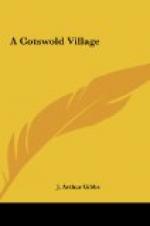I was told by a labourer that the trout ran from a quarter of a pound to three pounds, and that they average one pound in weight; that in the “may-fly” season a score of fish are often taken in the day by one rod, and that the method of taking them is by the artificial fly, well dried and deftly floated over feeding fish. These Cotswold streams are fed at intervals of about half a mile by the most beautiful springs, and from the rock comes pouring forth an everlasting supply of the purest and clearest of water. I was shown such a spring in a withybed hard by the old manor house. I saw nothing at first but a still, transparent pool, nine feet deep (they told me); it looked but three! But as I gaze at the beautiful fernlike weeds at the bottom, they are seen to be gently fanned by the water that rises—never failing even in the hottest and driest of summers—from the invisible rock below. The whole scene—the silent pool at my feet, the rich, well-timbered valley, with its marked contrast to the cold hills that overlook it—reminded me forcibly of Whyte-Melville’s lines at the conclusion of the most impressive poem he ever wrote: “The Fairies’ Spring”:
“And sweet to
the thirsting lips of men
Is the spring
of tears in the fairies’ glen.”
Out of this fairy spring was taken quite recently, but not with the “dry” fly—for no fish could be deceived in water of such stainless transparency—a trout that weighed three pounds and a half. He was far and away the most beautiful trout we ever saw; as silvery as a salmon that has just left the sea, he was a worthy denizen of the secluded depths of that crystal spring, still welling up from the pure limestone rock in the heart of the Cotswold Hills, as it has for a thousand years.
I was told that the place was still owned by the descendants of the pious John Coxwell who built the manor house and commemorated it by the quaint inscription over the porch in 1590. Doubtless the architecture of all our Elizabethan manor houses in the shape of a letter E owes its origin to the first letter in the name of that great queen.
That year was a fitting time for the building of “those haunts of ancient peace” that have ever since beautified the villages of rural England. Not two years before men’s minds had been stirred to a pitch of deep religious enthusiasm by what was then regarded throughout all England as a divine miracle—the destruction of the Spanish Armada. Scarce three years had passed since the war with Scotland had terminated in the execution of the ill-fated Mary Queen of Scots. It is difficult for us, at the close of this nineteenth century, to realise the feelings of our ancestors in those times of daily terror and anxiety. And when men were daily executed, and human life was held as cheap as we now value a sheep or an ox, no wonder John Coxwell was pious, and no wonder he engraved that pious inscription over those crumbling walls.




